Study on the Wettability and Abrasion Resistance of Ultrafast-Laser-Textured Ti Surface
Abstract
:1. Introduction
2. Experiments and Methods
2.1. Surface Ti Modification—Ultrafast Laser Processing and Chemical Modification
2.2. Characterization and Analysis (Math.)
3. Results and Discussion
3.1. Microstructure Characterization
3.2. Wettability Study
3.3. Tribological Property Analysis
4. Conclusions
- (1)
- The morphology of the Ti surface processed with an ultrafast laser is more uniform, and the textured surface exhibits better hydrophobicity compared with the flat surface, and the greater the structural density of the textured Ti surface, the better its hydrophobicity.
- (2)
- At a load of 10 N, an abrasion mark length of 2 mm, and a frequency of 2 Hz on the textured surface, the wear resistance of the two structures is best when the structural density of the pit is 20%, the structural density of the grooves is 70%, and the structural wear resistance of the grooves is better than that of the circular pits.
- (3)
- According to the wear resistance mechanism of the superhydrophobic circular pit structures and groove structures, it can be inferred that under hydrophobic conditions, the ultrafast-laser-etched groove structure exhibits better wear resistance compared to the circular pit structure because the groove structure not only stores more friction-generated abrasive particles but also allows the exfoliated abrasive particles to exhibit a rolling lubrication effect during friction and, therefore, reduces the surface wear more effectively.
Author Contributions
Funding
Institutional Review Board Statement
Informed Consent Statement
Data Availability Statement
Acknowledgments
Conflicts of Interest
References
- Jiang, L.; Huang, W.; Liu, C.; Guo, Y.; Chen, C.; Wang, J.; Yu, W. The effects of stored energy on wear resistance of friction stir processed pure Ti. Results Phys. 2019, 12, 1276–1284. [Google Scholar] [CrossRef]
- Brunette, D.M.; Tengvall, P.; Textor, M.; Thomsen, P. Titanium in Medicine: Material Science, Surface Science, Engineering, Biological Responses and Medical Applications; Springer: Berlin/Heidelberg, Germany, 2001. [Google Scholar]
- Olmedo, D.G.; Tasat, D.; Duffó, G.S.; Cabrini, R.; Guglielmotti, M.B. Systemic and Local Tissue Response to Titanium Corrosion; In Tech: Rejeka, Croatia, 2012. [Google Scholar]
- Tan, T.; Zhao, Q.; Kuwae, H.; Ueno, T.; Chen, P.; Tsutsumi, Y.; Mizuno, J.; Hanawa, T.; Wakabayashi, N. Surface properties and biocompatibility of sandblasted and acid-etched titanium–zirconium binary alloys with various compositions. Dent. Mater. J. 2022, 41, 266–272. [Google Scholar] [CrossRef] [PubMed]
- Olander, J.; Ruud, A.; Wennerberg, A.; Stenport, V.F. Wear particle release at the interface of dental implant components: Effects of different material combinations. An in vitro study. Dent. Mater. 2022, 38, 508–516. [Google Scholar] [CrossRef] [PubMed]
- Plant, S.D.; Grant, D.M.; Leach, L. Behaviour of human endothelial cells on surface modified NiTi alloy. Biomaterials 2005, 26, 5359–5367. [Google Scholar] [CrossRef] [PubMed]
- Bailey, R.; Sun, Y. Unlubricated sliding friction and wear characteristics of thermally oxidized commercially pure titanium. Wear 2013, 308, 61–70. [Google Scholar] [CrossRef]
- Ramachandran, R.A.; Barão, V.A.; Ozevin, D.; Sukotjo, C.; Pai, P.S.; Mathew, M. Early predicting tribocorrosion rate of dental implant titanium materials using random forest machine learning models. Tribol. Int. 2023, 187, 108735. [Google Scholar] [CrossRef] [PubMed]
- Barão, V.A.; Ramachandran, R.A.; Matos, A.O.; Badhe, R.V.; Grandini, C.R.; Sukotjo, C.; Ozevin, D.; Mathew, M. Prediction of tribocorrosion processes in titanium-based dental implants using acoustic emission technique: Initial outcome. Mater. Sci. Eng. C 2021, 123, 112000. [Google Scholar] [CrossRef] [PubMed]
- Chen, K.; Yang, X.; Zhang, Y.; Yang, H.; Lv, G.; Gao, Y. Research progress of improving surface friction properties by surface texture technology. Int. J. Adv. Manuf. Technol. 2021, 116, 2797–2821. [Google Scholar] [CrossRef]
- Nsilani Kouediatouka, A.; Ma, Q.; Liu, Q.; Mawignon, F.J.; Rafique, F.; Dong, G. Design methodology and application of surface texture: A review. Coatings 2022, 12, 1015. [Google Scholar] [CrossRef]
- Zheng, J.X.; Tian, K.S.; Qi, J.Y.; Guo, M.R.; Liu, X.Q. Advances in fabrication of micro-optical components by femtosecond laser with etching technology. Opt. Laser Technol. 2023, 167, 109793. [Google Scholar] [CrossRef]
- Gu, Y.; Xia, K.; Wu, D.; Mou, J.; Zheng, S. Technical characteristics and wear-resistant mechanism of nano coatings: A review. Coatings 2020, 10, 233. [Google Scholar] [CrossRef]
- Xing, H.; Wang, X.; Xiao, G.; Zhao, Z.; Zou, S.; Li, M.; Richardson, J.J.; Tardy, B.L.; Xie, L.; Komasa, S.; et al. Hierarchical assembly of nanostructured coating for siRNA-based dual therapy of bone regeneration and revascularization. Biomaterials 2020, 235, 119784. [Google Scholar] [CrossRef]
- Silva, G.A.F.; Faot, F.; da Rosa Possebon, A.P.; da Silva, W.J.; Cury, A.A.D.B. Effect of macrogeometry and bone type on insertion torque, primary stability, surface topography damage and titanium release of dental implants during surgical insertion into artificial bone. J. Mech. Behav. Biomed. Mater. 2021, 119, 104515. [Google Scholar] [CrossRef]
- Deppe, H.; Grünberg, C.; Thomas, M.; Sculean, A.; Benner, K.-U.; Bauer, F.J.M. Surface morphology analysis of dental implants following insertion into bone using scanning electron microscopy: A pilot study. Clin. Oral Implants Res. 2015, 26, 1261–1266. [Google Scholar] [CrossRef]
- Guan, H.; Van Staden, R.; Loo, Y.C.; Johnson, N.; Ivanovski, S.; Meredith, N. Influence of bone and dental implant parameters on stress distribution in the mandible: A finite element study. Int. J. Oral Maxillofac. Implants 2009, 24, 866–876. [Google Scholar]
- Song, J.; Huang, H.; Wang, X.; Shi, W. Status and prospects of surface texturing: Design, manufacturing and applications. Surf. Sci. Technol. 2023, 1, 21. [Google Scholar] [CrossRef]
- Earl, C.; Castrejón-Pita, J.R.; Hilton, P.A.; O’Neill, W. The dynamics of laser surface modification. J. Manuf. Process. 2016, 21, 214–223. [Google Scholar] [CrossRef]
- Pan, X.; Cai, Z.; Wang, X.; Liu, P.; Luo, S.; Zhou, L. Investigations on femtosecond laser-induced surface modification and periodic micropatterning with anti-friction properties on Ti6Al4V titanium alloy. Chin. J. Aeronaut. 2022, 35, 521–537. [Google Scholar] [CrossRef]
- Kirner, S.V.; Slachciak, N.; Elert, A.M.; Griepentrog, M.; Fischer, D.; Hertwig, A.; Sahre, M.; Dörfel, I.; Sturm, H.; Pentzien, S.; et al. Tribological performance of titanium samples oxidized by fs-laser radiation, thermal heating, or electrochemical anodization. Appl. Phys. A 2018, 124, 326. [Google Scholar] [CrossRef]
- Li, M.; Li, Y.; Xue, F.; Jing, X. A robust and versatile superhydrophobic coating: Wear-resistance study upon sandpaper abrasion. Appl. Surf. Sci. 2019, 480, 738–748. [Google Scholar] [CrossRef]
- Jiao, Y.; Zhang, T.; Ji, J.; Guo, Y.; Wang, Z.; Tao, T.; Xu, J.; Liu, X.; Liu, K. Functional Microtextured Superhydrophobic Surface with Excellent Anti-Wear Resistance and Friction Reduction Properties. Langmuir 2022, 38, 13166–13176. [Google Scholar] [CrossRef] [PubMed]
- He, Y.; Wang, L.; Wu, T.; Wu, Z.; Chen, Y.; Yin, K. Facile fabrication of hierarchical textures for substrate-independent and durable superhydrophobic surfaces. Nanoscale 2022, 14, 9392–9400. [Google Scholar] [CrossRef] [PubMed]
- Yang, Z.; Zhu, C.; Zheng, N.; Le, D.; Zhou, J. Superhydrophobic Surface Preparation and Wettability Transition of Titanium Alloy with Micro/Nano Hierarchical Texture. Materials 2018, 11, 2210. [Google Scholar] [CrossRef] [PubMed]
- Liu, T.L.; Chen, Z.; Kim, C.J. A dynamic Cassie-Baxter model. Soft Matter 2015, 11, 1589–1596. [Google Scholar] [CrossRef] [PubMed]
- Khaskhoussi, A.; Calabrese, L.; Patané, S.; Proverbio, E. Effect of chemical surface texturing on the superhydrophobic behavior of micro–nano-roughened AA6082 surfaces. Materials 2021, 14, 7161. [Google Scholar] [CrossRef] [PubMed]
- Berni, M.; Marchiori, G.; Gambardella, A.; Boi, M.; Bianchi, M.; Russo, A.; Visani, A.; Marcacci, M.; Pavan, P.; Lopomo, N. Effects of working gas pressure on zirconium dioxide thin film prepared by pulsed plasma deposition: Roughness, wettability, friction and wear characteristics. J. Mech. Behav. Biomed. Mater. 2017, 72, 200–208. [Google Scholar] [CrossRef] [PubMed]
- Wenzel, R.N. Resistance of solid surfaces to wetting by water. Ind. Eng. Chem. 1936, 28, 988–994. [Google Scholar] [CrossRef]
- Huang, M.; Zhao, F.; Cheng, Y.; Xu, N.; Xu, Z. Origin of laser-induced near-subwavelength ripples: Interference betwee surface plasmons and incident laser. ACS Nano 2009, 3, 4062–4070. [Google Scholar] [CrossRef] [PubMed]
- Greczynski, G.; Hultman, L. Compromising science by ignorant instrument calibration-need to revisit half a century of published XPS data. Angew. Chem. 2020, 132, 5034–5038. [Google Scholar] [CrossRef]
- Greczynski, G.; Hultman, L. Reliable determination of chemical state in x-ray photoelectron spectroscopy based on sample-work-function referencing to adventitious carbon: Resolving the myth of apparent constant binding energy of the C1s peak. Appl. Surf. Sci. 2018, 451, 99–103. [Google Scholar] [CrossRef]
- Kroger, F.A.; Vink, H.J. Relations between the concentrations of imperfections in crystalline solids. J. Phys. Chem. Solids 1958, 5, 307–435. [Google Scholar] [CrossRef]
- Kröger, F.A.; Nachtrieb, N.H. The Chemistry of Imperfect Crystals. Phys. Today 1964, 17, 66–69. [Google Scholar] [CrossRef]
- Krishna, D.N.G.; Philip, J. Review on surface-characterization applications of X-ray photoelectron spectroscopy (XPS): Recent developments and challenges. Appl. Surf. Sci. Adv. 2022, 12, 100332. [Google Scholar] [CrossRef]
- Hierro-Oliva, M.; Gallardo-Moreno, A.M.; González-Martín, M.L. XPS Analysis of Ti6Al4V Oxidation under UHV Conditions. Metall. Mater. Trans. A 2014, 45, 6285–6290. [Google Scholar] [CrossRef]
- Li, X.X.; Zhou, Y.; Li, Y.X.; Ji, X.L.; Wang, S.Q. Dry Sliding Wear Characteristics of Ti-6.5Al-3.5Mo-1.5Zr-0.3Si Alloy at Various Sliding Speeds. Metall. Mater. Trans. A 2015, 46, 4360–4368. [Google Scholar] [CrossRef]
- Cassie, A.B.D.; Baxter, S. Wettability of porous surfaces. Trans. Faraday Soc. 1944, 40, 546–551. [Google Scholar] [CrossRef]
- Gu, Y.; Yan, M.; Yu, J.; Xia, K.; Ma, L.; Mou, J.; Wu, D.; Tang, J. Effect of the Bionic Circular Groove Non-Smooth Structure on the Anti-Wear Performance of the Two-Vane Pump. Lubricants 2022, 10, 231. [Google Scholar] [CrossRef]
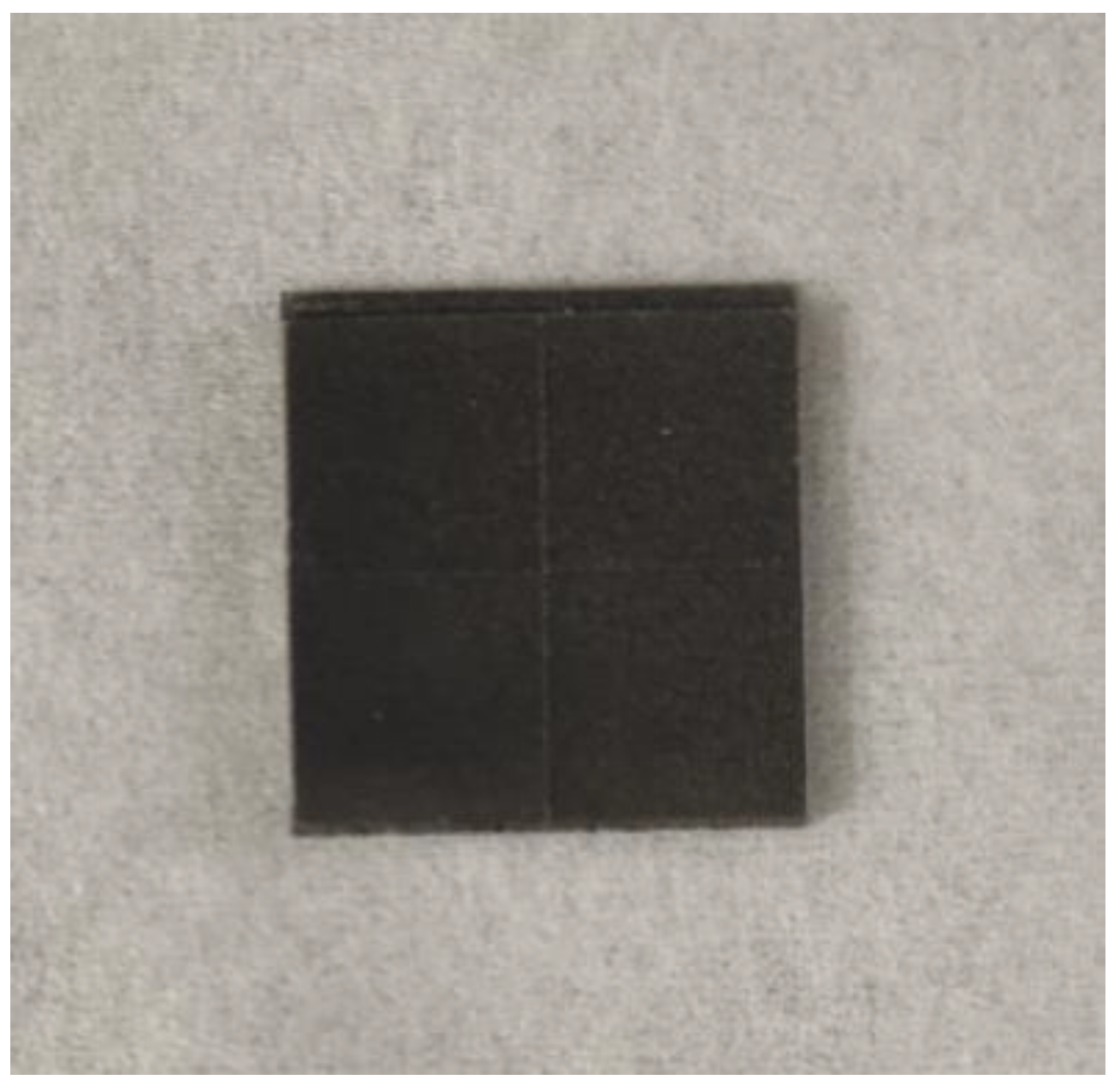
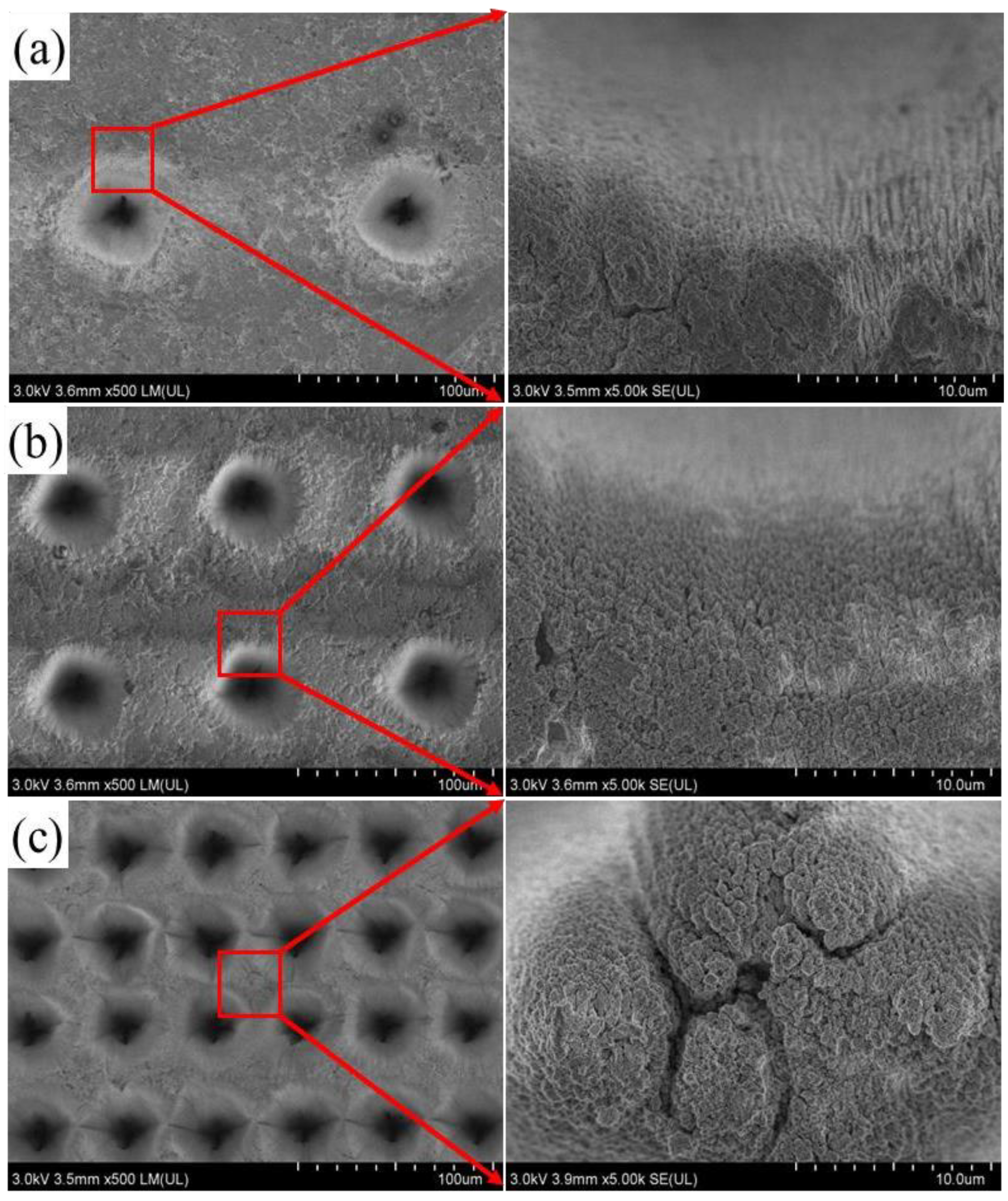
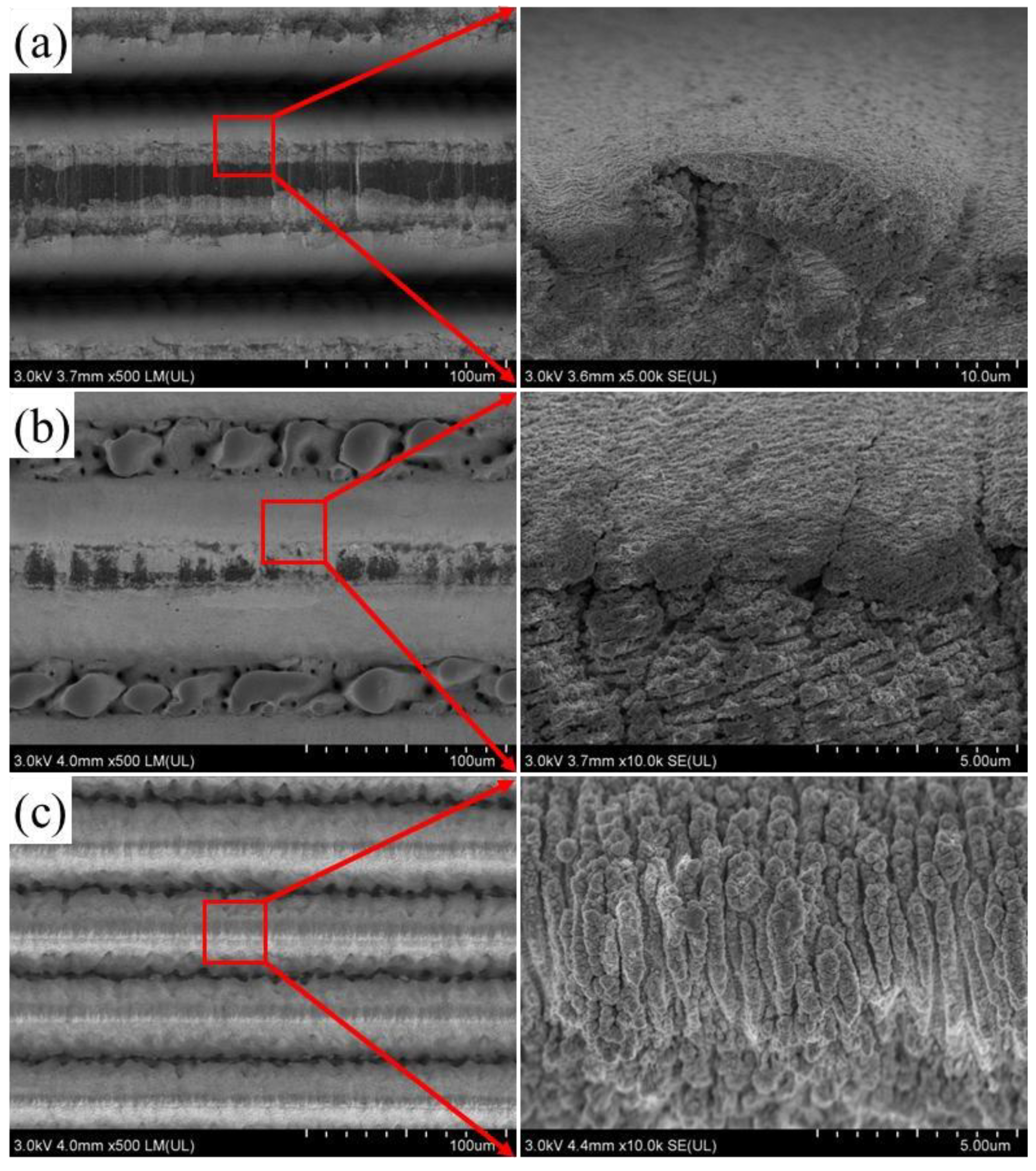
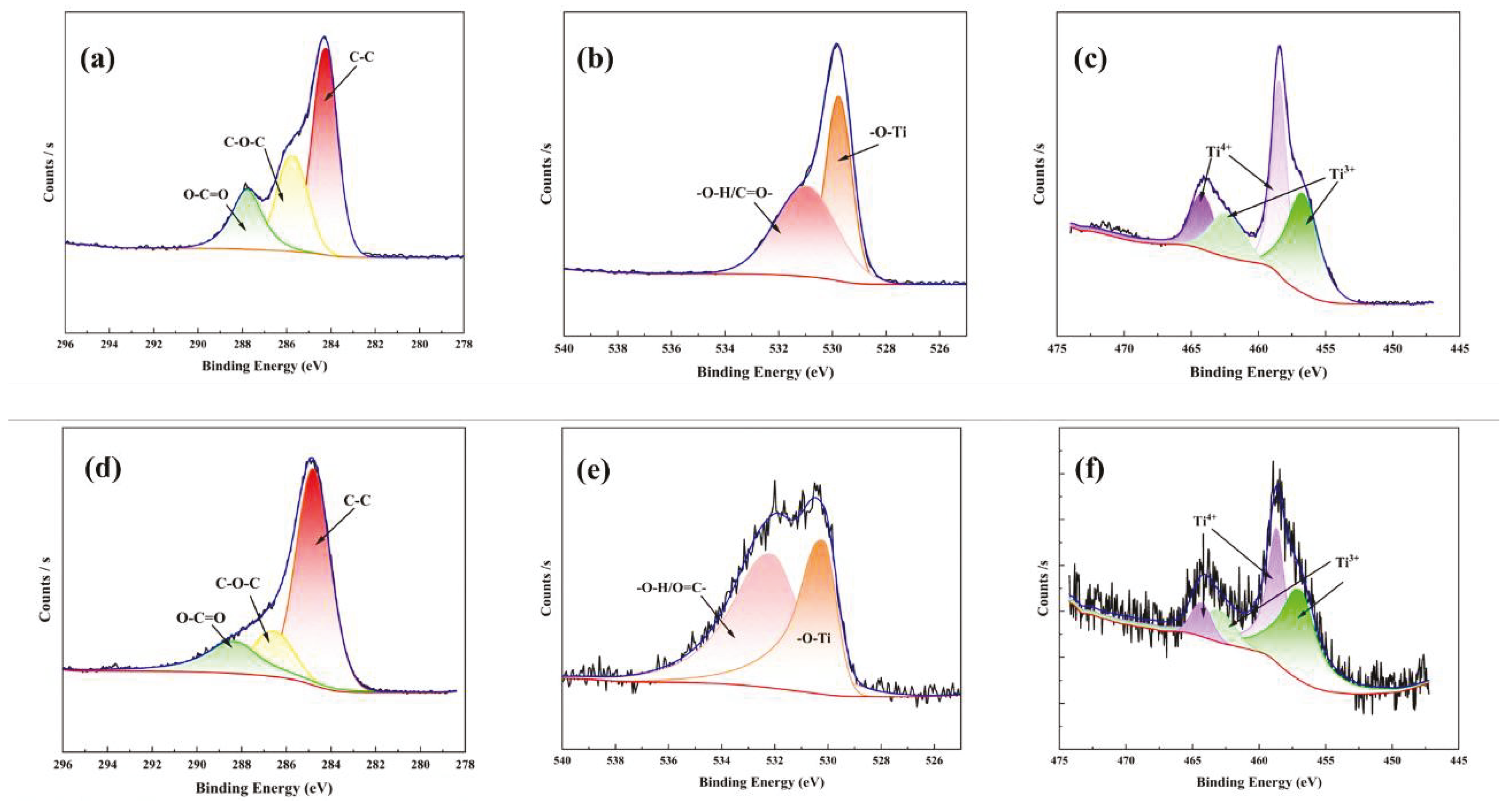


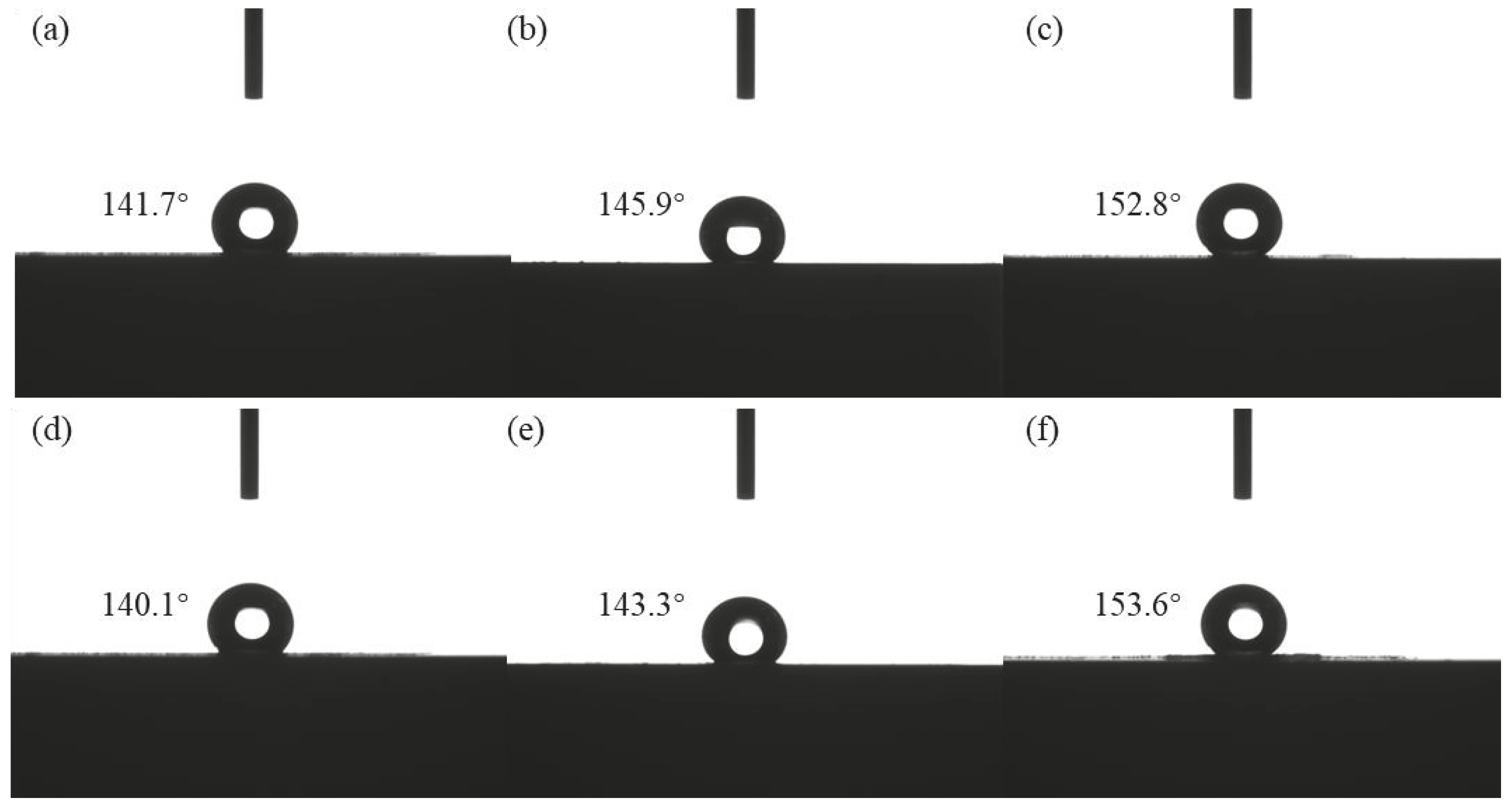



| Denoted Name | Shape | Diameter | Depth | Density |
|---|---|---|---|---|
| K1 | 45 | 50 | 10% | |
| K2 | Circle | 45 | 50 | 20% |
| K3 | 45 | 50 | 90% | |
| C1 | 50 | 50 | 50% | |
| C2 | Groove | 50 | 50 | 70% |
| C3 | 50 | 50 | 90% |
| Denoted Name | Shape | Diameter | Depth | Density |
|---|---|---|---|---|
| Kt1 | 45 | 50 | 10% | |
| Kt2 | Circle | 45 | 50 | 20% |
| Kt3 | 45 | 50 | 90% | |
| Ct1 | 50 | 50 | 50% | |
| Ct2 | Groove | 50 | 50 | 70% |
| Ct3 | 50 | 50 | 90% |
| Ti Substrate | K1 | K2 | K3 | C1 | C2 | C3 | |
| Contact angle | 66.5° | 119.4° | 120.5° | 131.6° | 110.3° | 119.6° | 122.7° |
| Ti Substrate | Kt1 | Kt2 | Kt3 | Ct1 | Ct2 | Ct3 | |
| Contact angle after modification | 94.4° | 141.7° | 145.9° | 152.8° | 140.1° | 143.3° | 153.6° |
| Ti Substrate | K1 | K2 | K3 | C1 | C2 | C3 | |
| Ra | 1.3 ± 0.04 | 1.5 ± 0.05 | 1.6 ± 0.06 | 1.8 ± 0.03 | 1.6 ± 0.07 | 1.7 ± 0.04 | 1.9 ± 0.05 |
| Rq | 1.4 ± 0.07 | 1.6 ± 0.06 | 1.7 ± 0.07 | 1.9 ± 0.04 | 1.7 ± 0.08 | 1.8 ± 0.05 | 2.0 ± 0.06 |
| Ti Substrate | Kt1 | Kt2 | Kt3 | Ct1 | Ct2 | Ct3 | |
| Ra after modification | 1.4 ± 0.01 | 1.6 ± 0.08 | 1.7 ± 0.05 | 2.0 ± 0.07 | 1.7 ± 0.02 | 1.8 ± 0.06 | 2.0 ± 0.03 |
| Rq after modification | 1.5 ± 0.03 | 1.7 ± 0.09 | 1.8 ± 0.02 | 2.1 ± 0.09 | 1.8 ± 0.05 | 1.9 ± 0.08 | 2.1 ± 0.04 |
Disclaimer/Publisher’s Note: The statements, opinions and data contained in all publications are solely those of the individual author(s) and contributor(s) and not of MDPI and/or the editor(s). MDPI and/or the editor(s) disclaim responsibility for any injury to people or property resulting from any ideas, methods, instructions or products referred to in the content. |
© 2024 by the authors. Licensee MDPI, Basel, Switzerland. This article is an open access article distributed under the terms and conditions of the Creative Commons Attribution (CC BY) license (https://creativecommons.org/licenses/by/4.0/).
Share and Cite
Hou, Y.; Guo, W.; Sun, P.; Zhang, Y.; Ding, T.; Xing, Z.; Yang, S. Study on the Wettability and Abrasion Resistance of Ultrafast-Laser-Textured Ti Surface. Coatings 2024, 14, 516. https://doi.org/10.3390/coatings14040516
Hou Y, Guo W, Sun P, Zhang Y, Ding T, Xing Z, Yang S. Study on the Wettability and Abrasion Resistance of Ultrafast-Laser-Textured Ti Surface. Coatings. 2024; 14(4):516. https://doi.org/10.3390/coatings14040516
Chicago/Turabian StyleHou, Yuankun, Weiling Guo, Pengyuan Sun, Yanfang Zhang, Tong Ding, Zhiguo Xing, and Sefei Yang. 2024. "Study on the Wettability and Abrasion Resistance of Ultrafast-Laser-Textured Ti Surface" Coatings 14, no. 4: 516. https://doi.org/10.3390/coatings14040516





